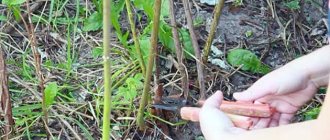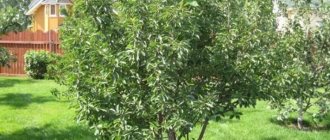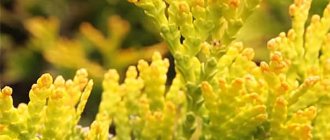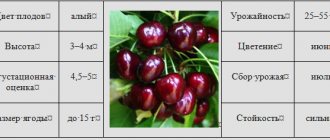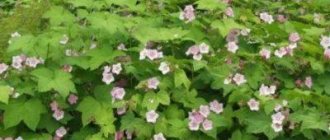Description of the berry crop
Triple Crown blackberries have been and remain one of the best dessert varieties. In our country it is grown on private farms, but for America it is an industrial variety. There, in blackberries intended for fresh consumption, the main thing is taste, not yield.
General idea of the variety
Bushy blackberry Triple Crown forms a powerful bush with semi-creeping shoots. Already in the first year after planting, the lashes grow up to 2 m; later, without pinching, they reach 3 m. There are no thorns along the entire length of the shoot.
The leaves of the Triple Crown blackberry are difficult to confuse with another variety - in shape and density they are similar to black currants. Shoot-forming ability is good. The root system is powerful. Flowers and berries are formed on last year's growth.
Berries
Triple Crown berries are large, with an average weight of 7-9 g, collected in clusters. Their shape can be round, slightly elongated or oval, the color is black, with a characteristic glossy sheen. According to gardeners' reviews of Triple Crown blackberries, the fruits of the last harvest are as large as the first berries. The drupes are small.
The berries are sweet, with a plum or cherry aroma and a pleasant sour note. The tasting assessment of the fruit and reviews of the Triple Crown blackberry by domestic connoisseurs coincide - 4.8 points.
About diseases and pests
Triple Crown is attractive to summer residents due to its resistance to disease, but this variety is sometimes attacked by bacteria and fungi. The most common diseases for Triple Crown:
- Phragmidium ruby is a fungal infection also called rust; yellow spores first cover the foliage, then quickly spread throughout the plant; on buds and shoots, mature spores look like black dots;
- Septoria - bacteria infect shoots, changing the color of the bark on them; the stems crack, the buds fall off; if the fruits have already set, they stop developing and do not ripen.
These problems are eliminated at the initial stage of development so as not to completely lose the berry plant. To treat the bushes, use an infusion of garlic or milkweed (200 g per 2 liters of water). The solution is infused for a day, then filtered. Since the infusion turns out to be concentrated, it must be further diluted in a ratio of one to twenty and only then sprayed on the plants.
Characteristic
The characteristics of the blackberry variety Triple Crown (Triple Crown) are reliable, as they have been time-tested. Twenty years is a long period of time, and you can check the yield under different conditions and the reaction to weather disasters.
If in America the Triple Crown blackberry is grown mainly on industrial plantations, then in our country it has mostly won the hearts of amateur gardeners and small farmers. It's all about priorities. Triple Crown's yield is average, although sufficient for a dessert crop. And in Russia and neighboring countries, the main thing for large farms is abundant fruiting. In the USA, they pay attention to the taste - consumers there are spoiled by the variety of blackberry varieties and will not eat sour or bitter berries just because they are healthy.
Main advantages
When describing the blackberry variety Triple Crown (Triple Crown), the main emphasis is on excellent taste, high transportability of berries and the absence of thorns. But in America, where this crop is industrially grown, the climate is mild and the winters are warm. Therefore, other characteristics are of great importance to us.
The winter hardiness of Triple Crown blackberries is low. It needs to be covered even in the central and some southern regions of Ukraine. In Russia, especially in the central zone, without insulation for the winter, the bush will simply die.
But the resistance to heat and drought in the Triple Crown variety is excellent. The berries do not bake in summer, and with sufficient watering they do not shrink. Moreover, the variety needs to be shaded only in the hottest summer with active sun.
Triple Crown blackberries have increased demands on soil fertility. The variety is not very picky when it comes to care, but when growing there are some nuances that must be taken into account if you want to get a decent harvest.
Yield indicators, fruiting dates
Fruiting of Triple Crown blackberries, depending on the region, begins in late July or early August and lasts a month or more. This is considered a medium-late ripening period for berries.
For cold climates, the Triple Crown variety is very controversial. Late flowering allows you to avoid return frosts, but fruiting extended until September may not allow gardeners to collect 10-15% of the berries.
Advice! The blackberry tops, along with the flowers and berries, can be dried and drunk as tea. They are much healthier and tastier than leaves. You can stock them even after the first frost.
The yield of the Triple Crown is about 13 kg of berries from an adult bush. Perhaps this may not seem enough to some, but only against the backdrop of technical varieties. Among the elite blackberries, the most productive is Triple Crown.
Area of application of berries
Triple Crown blackberries are a dessert variety. It is eaten fresh, the berries are well stored in a cool room and transported without loss. Juices, wines, preparations and freezing for the winter, berry desserts and baked goods - all this can be made from the fruits of the Triple Crown.
Resistance to diseases and pests
The blackberry variety Triple Crown is resistant to diseases and is rarely affected by pests. This does not negate preventive treatments, especially in dense plantings on industrial plantations.
Advantages and disadvantages
Triple Crown blackberries are both a dessert variety and grown commercially. For more than 20 years in the USA it has been considered one of the best varieties. The undoubted advantages include:
- Beautiful large berries.
- Good taste.
- High (for a dessert variety) yield.
- No thorns.
- Excellent transportability of berries.
- High resistance to heat and drought.
- Possibility of compacted landing.
- High resistance to diseases and pests.
- The berries of the last harvest are almost the same in size as the first ones.
Among the disadvantages of the Triple Crown variety are:
- Low frost resistance.
- Average yield.
- Powerful shoots make shelter for the winter difficult.
- Late fruiting.
- In the northern regions, not all berries have time to ripen before frost.
- When planted sparsely in the southern regions, the variety still suffers from the heat.
Features of berry propagation
Thornless blackberry
In order to get “babies” from an already fruiting triple crown blackberry bush, in the spring some of the side shoots formed last year are slightly shortened and bent to the ground. Having secured the branches to the ground with small staples so that they do not straighten, sprinkle them with a 10 cm layer of soil. After this, the cuttings must be watered abundantly.
The stems prepared for propagation will take root thoroughly by the end of summer, but it is necessary to separate them from the mother bush only next spring, otherwise they will not survive the winter. When the next growing season comes, the “baby” is separated from the bush and transplanted to another area.
Landing rules
Planting and caring for Triple Crown blackberries in the spring and throughout the season differs little from other varieties.
Recommended timing
In the southern regions, it is recommended to plant blackberries in the fall, at least a month before the first frost. It’s even better to start excavation work as soon as the heat subsides. Usually the right time is late September - early October. In the central regions of Ukraine and southern Russia, planting can be done until the beginning of November.
In other regions, spring planting is recommended. During the warm season, the blackberries will have time to take root and safely survive the harsh winter.
Choosing a suitable location
In the middle zone and colder areas, Triple Crown blackberries are planted in a sunny place protected from cold winds. In the south, you can choose a slightly shaded area of the garden. Groundwater should be located no closer than 1-1.5 m from the surface.
Triple Crown blackberries are more demanding on soils than other varieties, especially when planted in dense areas.
Soil preparation
A hole is dug with a diameter and depth of 50 cm. A fertile mixture for planting must be prepared - mix the top layer of soil, a bucket of humus, 50 g of potassium fertilizer and 120-150 of phosphorus. Add acidic peat to alkaline or neutral soil. Calcareous soil is improved by adding humus, and clayey soil by adding sand. Lime is added to acidic soil.
Important! Some gardeners prepare a fertile mixture using only what is on the farm, or rely on chance and simply dig a hole in which to plant blackberries. This is generally wrong, and the Triple Crown variety is especially picky about the composition of the soil.
The planting hole is filled 2/3 with fertile soil, filled with water and allowed to settle for 10-14 days.
Selection and preparation of seedlings
Seedlings should not be bought secondhand. So you may end up with a variety that is completely different from what you expected. It is better to purchase them from nurseries or trusted retail chains.
The seedling must have a strong, flexible shoot with smooth, intact bark. In the Triple Crown variety it is devoid of thorns. The root should be developed, flexible, and smell of fresh earth.
Before planting, container blackberries are watered and the exposed root system is soaked in water for 12 hours. To improve survival rate, heteroauxin or another stimulant can be added to the liquid.
Algorithm and landing scheme
The planting scheme for Triple Crown blackberries is calculated differently from other varieties. To obtain a larger harvest, bushes should be placed at a short distance from each other - 1.2-1.5 m. At least 2.5 m are left between rows. Industrial plantings are compacted even more.
Planting is carried out in the following sequence:
- A mound is formed in the center of the hole, and the blackberry roots are straightened around it.
- The fertile mixture is poured and compacted. The root collar should be buried 1.5-2 cm.
- The bush is watered with a bucket of water, the soil is mulched with acidic peat.
Rules for growing blackberries triple crown
blackberry triple crown photo
If you decide to grow blackberries on your site, you need to know its characteristics and care rules.
Firstly, you need to choose the right seedling, plant it correctly, organize the necessary further care and cover the plant before the cold, winter months. These manipulations do not require a lot of effort and time from the gardener, so anyone can grow blackberries on the plot, if climatic conditions permit.
Selection of seedlings
When choosing planting material, you should choose a bush that has at least two stems and at the same time the root system will be quite overgrown and strong, about 10 cm each root.
You should keep a moist ball of earth, and also inspect the roots for wrinkles. If you see wrinkles on the roots, this indicates that the plant was recently dug up. Such planting material will adapt poorly and grow slowly. Before planting, be sure to cut off the roots a little and treat the cuts with charcoal.
Landing place
In order for the fruits to ripen bright, juicy and large, you need to choose an open, sunny place on the site. It is best if the soil is alkaline or loamy. If you have acidic soil on your site, then you need to add wood ash. The optimal soil composition will be loam, where the clay mass is at least 15 cm. You should also choose areas with deep groundwater. The plant must be protected from drafts, so it is better to grow blackberries near a fence or some other structure. While maintaining a distance of at least a meter.
Planting period
The optimal time for planting will be the spring or autumn season. It is best to plant blackberries in the fall in the southern regions. Just in the autumn, the best rooting of the plant will occur, and the blackberry will have time to prepare for the winter season. Blackberries begin their growing season very quickly with the arrival of spring. Having planted a plant in the fall, in the spring the bush will begin to grow stems and leaves very quickly and will be able to bear fruit faster. Therefore, it is best to plant blackberries a few weeks before the expected frost.
During spring planting, blackberries grow very slowly and take root poorly, since the growing season begins, which stimulates the growth of green mass. The roots remain unrooted and unexpanded. Because of which culture will suffer in the future. If you decide to plant a plant in the spring, then you need to wait until the air temperature is about 15-20 degrees. In spring, it is best to plant blackberries in the northern regions.
Landing
The planting hole should be prepared in advance. Remove weeds, clear the area of debris, stones and other plants, and also dig up the soil, adding an organic and mineral complex of fertilizers. The hole should be quite spacious, approximately 40 cm in all directions. Also be sure to add humus, superphosphate and potassium sulfate to the hole. Next, you need to dig everything up properly and fill the planting hole 2/3 full. The seedling is placed in a planting hole, and all the roots must be straightened so that the root collar is several centimeters below the surface of the earth. The top of the plant must be covered with the remaining soil and everything must be watered properly, and the soil around the bush must be compacted.
In order to retain moisture in the soil for as long as possible, and also to prevent weeds from interfering with the development of the plant, it is necessary to organize a sufficiently thick layer of mulch, which is ideal for straw, peat or sawdust. If you are planting several blackberries, then you must maintain a distance of at least 2 m between them.
It is very good to plant them along a hedge, as well as in an open area. When planting blackberries in an open area, you need to create a support from trellises to tie up tall shoots. For the design, it will be enough to take several two-meter slats, which will be located at a short distance from each other, and tie a wire between them. In this case, you need to make several tiers of wire: 50 cm, one meter and one and a half meters from the ground, respectively. As the plant gains strength, it should be tied up. First to the lower tier, then to the middle and then to the third. After the plant outgrows the third tier, the top needs to be pinched. This procedure stimulates the growth of lateral stems, and accordingly will increase the amount of harvest.
In addition, experienced gardeners tie this variety in a certain way. In this case, new stems are tied with a slope in one direction, and fruit-bearing branches in the opposite direction.
Subsequent care of the crop
In regions with cold and temperate climates, after planting, spring care for Triple Crown blackberries consists of regular watering twice a week. In the south, the variety is planted in the fall; if it rains often, additional moisture is not needed.
Growing principles
The yield of blackberries of the Triple Crown variety is affected by the planting scheme and garter. It has been noticed that fruiting increases if the bushes are located close to each other, and the shoots are attached to the trellis almost vertically. This is what distinguishes Triple Crown from other varieties, which prefer to grow freely and produce greater yields with increased feeding area.
You can choose a multi-row or T-shaped trellis. The optimal height is 1.8-2 m; more is simply not advisable. The canes are tied almost vertically, last year's fruiting ones - in one direction, young ones - in the other.
A decent harvest of Triple Crown blackberries can only be harvested with intensive feeding.
Necessary activities
The Triple Crown variety should be watered in dry weather once every 1-2 weeks. The frequency of moistening depends on the ambient temperature and soil structure. Blackberries love water, but not waterlogging of the root system. The rule applies to this crop: “If you are in doubt whether it is worth watering, water it.”
The Triple Crown variety needs intensive feeding - with dense plantings, the feeding area is small, and the load on the bush during fruiting is large:
- In early spring, the plant is given nitrogen.
- At the beginning of flowering, blackberries are fertilized with a complete mineral complex.
- During the formation of berries, the bush is fed 2 times with a solution of mullein infusion (1:10) or grass (1:4).
- After fruiting, the blackberries are watered with a solution of potassium monophosphate or another fertilizer of similar effect.
- Throughout the season, once every 2 weeks it is useful to spray the bush with foliar fertilizers, adding a chelate complex and epin or zircon.
Important! Fertilizers should not contain chlorine.
In spring and autumn, the soil under the blackberries is loosened. During the flowering and fruiting period, the soil is mulched with acidic peat or humus.
Shrub pruning
Immediately after fruiting, old shoots are cut into a ring close to the soil surface. In the spring, the lashes are normalized - 8-12 of the strongest are left. In order for the berries to be larger and ripen faster, the number of fruiting shoots should be reduced. This way the harvest will be reduced, but its quality will increase.
Young shoots are pinched 1-2 times in summer when they reach 40-45 cm in length. Some gardeners don't do this at all. Try what's best - everyone's conditions are different. Naturally, broken and weak shoots are cut out throughout the season.
Preparing for winter
In the fall, before the onset of frost, the lashes are removed from the trellis, bent to the ground and secured with staples. The easiest way to deal with upright thick shoots is to make a tunnel shelter.
Important! Many gardeners think about how they will tilt the vines to the ground in the spring. They “train” young shoots by pinning them to the ground until they grow to 30-40 cm.
A shelter for blackberries is constructed from spruce branches, straw, corn and Jerusalem artichoke stalks, agrofibre or spandbond, and dry soil.
Winter hardiness (frost resistance) of the variety
In berry crops, their frost resistance is valued. As for the triple crown, the plant is not suitable for the northern regions - it does not tolerate winters well. Even when grown in the Moscow region, the bushes will have to be carefully protected from freezing.
Note! Low winter hardiness is not the only disadvantage for areas with cold climates. In these areas, the bushes will not be able to bear fruit until October, as happens in the southern regions. Therefore, the plant will give a low yield, which makes the variety impractical for industrial cultivation.
And in areas with warm winters, blackberries should not be left without shelter. First, the stems are prepared as follows:
- removed from garters;
- those that bear fruit are pruned;
- replacement branches are laid on the ground and straightened so that they do not break.
The stems are first wrapped with spandex, then covered with polyethylene. If everything is done correctly, blackberries can easily withstand cold temperatures down to minus 15 degrees. Otherwise, the branches under the shelter will begin to rot and freeze.
This is how the Triple Crown winters
Reviews
I love the Triple Crown variety for its excellent berry taste. They are sweet, juicy, do not wrinkle during transportation and are perfectly stored for a long time in the refrigerator. For jam and other preparations, in my opinion, there are many technical varieties that are easier to care for and more productive. Triple Crown is first and foremost a great dessert! Variety
It's very tedious to prepare bushes for winter, but it's worth it. I have several varieties of blackberries, there are bushes that I don’t cover at all, I just cover them with snow, there are ones like Triple Crown that I can only keep an eye on. The first year I did not cover it with anything additionally - both seedlings died. The second year I was more careful and wrapped it in agrofibre, then I threw more spruce branches on top and in winter I made sure that the stems were always covered with snow. As a result, the seedlings overwintered well and began to grow actively. In the second year, it was more difficult to cover the long stems, but I followed the proven scheme and again the blackberries overwintered perfectly. The main thing in the spring is not to miss the moment when you need to gradually remove the shelter, otherwise the branches may begin to rot.
Triple Crown is an excellent dessert variety for true gourmets. Of course, you will have to tinker with it, but the result will more than repay all the time and effort.
167
Reviews
Maria
I have long wanted to plant blackberries at home and chose this variety based on reviews - everyone wrote that it was ideal and delicious. I was not disappointed - for the fifth year now it has delighted me and the whole family with amazing berries, and the children especially enjoy the picking process. We live in Krasnodar, our winters are warm, so we don’t even cover the bushes - they winter normally.
Maksim
Triple Crown is the most popular product in my company. Buyers instantly snap it up as soon as it appears. At the same time, the bushes require almost minimal care - water occasionally, trim shoots, protect from the cold. The variety is almost no more, the berries are excellent, they can be stored for 5-6 days if stored in professional refrigerators.
How to store and use
Unfortunately, blackberries are not a berry that can be stored for a long time. It is quite fragile, easily susceptible to mechanical stress and generally cannot stand on its own for weeks, like apples. The berries must be carefully collected in containers and stored in a cool place (ideally in the refrigerator), but even if these conditions are met, they will last only four to five days.
Triple Crown ripens gradually, so gardeners typically harvest little by little and have time to eat or freeze the berries before they begin to spoil.
Video
I’ve been working on my garden for eight years now - initially it was an ordinary dacha, which I inherited from my mother. I planted some berries in her memory and somehow imperceptibly became interested in caring for them - I began to study gardening first on the Internet, and then seriously - I received the appropriate education, I go to various trainings and seminars.
Two years ago I flew to the USA and was shocked at how popular blackberries are there - even small supermarkets sell dozens of varieties! But here, in the CIS countries, this berry is associated only with the forest and often grows simply wild. I think this is very unfair - blackberries are very tasty, healthy and at the same time easy to grow. Therefore, I decided to share with readers the secrets of growing one popular variety - Triple Crown or Triple Crown, in Russian.
Triple Crown Agricultural Practice Recommendations
Even an unpretentious plant of the North American prairie requires some care. The gardener's primary task when planting and growing large-fruited Triple Crown is to take care of organizing a strong trellis for powerful blackberry bushes.
- a tall Triple Crown on a trellis in a special way: as the branches grow, they are wrapped around the wire at a height of 50, 100, 150 and 200 cm. At the last level, the shoot is firmly fixed and cut. After such pruning, increased growth of lateral fruit branches of the 2nd order - the most productive - begins.
- Weeding and loosening of the root zone should be done very carefully - damage to the roots can cause uncontrolled growth of root suckers. To avoid such problems, it is recommended to replace weeding with mulching.
- Mulching solves the problem of lack of moisture. Blackberries should be watered only during the period of setting and filling the fruits, infrequently, but abundantly - approximately 10-20 liters. under the bush once a week.
- when feeding a berry bush - an excess of fertilizers does not increase the yield at all, but provokes the growth of green mass. The best way to feed, which will allow you not to “overfeed” the berry bush, is mulching with compost with the addition of wood ash.
- Preparing for the Triple Crown winter begins with removing fruit-bearing branches. Immediately after harvesting, the branches of the 2nd year of growth are cut out, as they say, “at the root.” In the time remaining before winter, the young branches will have time to gain strength. Cover the bushes with spunbond; you will need 2 layers of material with a density of at least 50. If a lower density spunbond is used, for example the popular 30, then before frost, cover with plastic film on top of the covering material.
- Triple Crown blackberries have good resistance to most diseases characteristic of the crop, but preventive treatments will not interfere with it. To avoid unnecessary chemicals, you can use a folk remedy based on garlic. To prepare, you need to dilute 100 g of chopped garlic in 1 liter. warm water and leave for 24 hours. Strain the resulting solution and dilute with water in a ratio of 1:20. Treat the plant in the morning or evening. The product helps well against septoria and rust. If aphids were found on blackberries, then tobacco will help in the fight against the pest. 100 g of tobacco is diluted in 5 liters. water and add a little liquid soap to the solution. The resulting mixture is treated with the bush.
Triple Crown responds well to foliar feeding. To protect against chlorosis, it is recommended to add a chelate complex to them.
At the end of October, after the first real frost, the branches of the Triple Crown are removed from their supports. It is necessary to inspect the shoots and discard weak and damaged ones. Flexible branches without thorns should be tied into bunches and pressed to the ground with boards or arches. Insufficient winter hardiness of the variety requires covering the blackberry branches with a layer of spunbond or burlap in the conditions of the Middle Zone. Snow cover will finally help protect the bush from frost.
